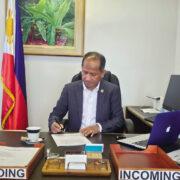A YEAR ago, the Philippines welcomed an unwanted visitor. Super Typhoon Yolanda (international name Haiyan) with winds up to 235 kilometers per hour and a tsunami-like storm surge ravaged most parts of the country, causing 6,300 lives.
Homes, schools, hospitals, churches were destroyed. It seemed that all that was left was hope.
The government, in cooperation with the private sector and non-government units, has been in full force in the relief, recovery and rehabilitation efforts.
“After every storm the sun will smile; for every problem there is a solution, and the soul’s indefeasible duty is to be of good cheer,” William Alger, an American writer once said.
For a storm as ferocious as Yolanda, a year may not be enough to see the sun shine as bright as it once did. It might take more especially for the people left behind by their dead loved ones.
However, Filipinos’ resilience remains intact.
“We are humbled by the extraordinary resilience of the Filipino people who, despite the unprecedented destruction and tragedy that struck, pushed through individually and collectively, and with generosity of spirit, to this point where recovery is well underway,” Luiza Carvalho, United Nations resident and humanitarian coordinator in the Philippines said in a statement.
“We recognize that ‘building back better’ will be a complex and long process, particularly the rehabilitation of human settlements and the restoration of livelihoods,” Carvalho said, citing that the government has “clearly outlined the work that lies ahead.”
President Benigno Aquino III recently approved the full implementation of the P170 billion-worth Comprehensive Rehabilitation and Recovery Plan (CRRP) expected to be completed by 2016.
Senator Loren Legarda, a UN Champion for Disaster and Risk Reduction and Climate Change Adaptation encourages everyone to bring resilience to another level.
“One year after Yolanda devastated numerous communities in Central Visayas, I hope we all have learned our lessons well. Let us bring our resilience to a higher level—where we need not weep for a lost loved one after a natural hazard and where there is less or no more damaged infrastructure and properties because we have already managed to make our communities safe,” Legarda said, adding that re-building in a joint effort.
“We need to ensure that the reconstruction of homes and infrastructure will be on safer ground following geohazard maps and sound construction standards.”
“We need to restart and create livelihoods and restore normalcy to people’s lives with a stronger sense of hope and confidence for the future,” she said..
(AJPress)



